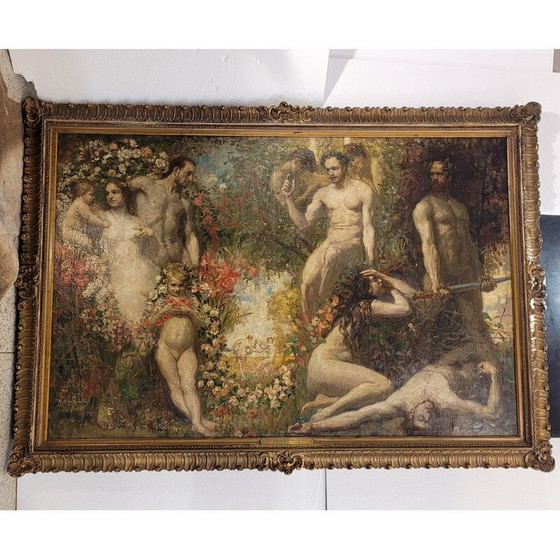Have it delivered hassle-freeBuyer protectionAll items curated by WhoppahDownload the Whoppah app here

Vintage painting "Peace and the Arts are better than the brutal Glory of Arms" by Philippe Swyncop
Seller: Business seller€20,000Offer from €18,000
Item not as advertised, money backAll items are curated and 100% authenticHave it delivered hassle-free or pick it up yourselfShop only from Trusted Sellers
Business seller
Product description
Exquisite oil on canvas signed and dated by Belgian artist Philippe Swyncop (1878 - 1949) in the lower left corner. The plaque at the bottom of the frame reads: “La Paix et les Arts valent mieux que la Gloire brutale des armes”; That is to say, Peace and the arts are worth more than the brutal glory of weapons. The canvas represents, therefore, an allegory about the triumph of peace and the arts in the face of the brutal consequences of war.
On the right side, standing, a man representing war, immersed in shadows and holding the sword with which he has just killed a young man, whose body appears lying on the ground in a violent foreshortening, whose head seems to pierce the limits of the canvas. Next to her, a woman cries inconsolably for the loss, representing the devastation and horrors caused by the war.
And in the face of war, the arts. On the left side the vegetation becomes lush. The color accompanies the meaning of the work. All the meaning seems contained in the infant, the only figure that looks directly at the viewer and appears smiling.
In this work the characteristics of Flemish painting can be seen. This school had its origin in the 15th century, and assumed a fundamental role in the History of European Art during the 15th, 16th and 17th centuries, although its influence continued during subsequent centuries. During the Baroque period, Rubens was the most influential author and the one who best expressed the tendencies of this movement. Rubens' work is marked by his time in Italy, where he dedicated himself to the study of classical antiquity and the Italian Renaissance, especially attracted by the Venetian school and by authors such as Caravaggio and Annibale Carracci, from whom he took his sensitivity and sense of beauty compatible with the energetic expression of feelings. Due to the influence of Flemish painting, the figures appear round and voluminous, with a very precise anatomical study. He also highlights the complexity of the composition, with numerous figures and a complicated arrangement. The importance of color in relation to drawing cannot be ignored either, to which is added the loose and vaporous brushstroke, still reminiscent of Rubens' study and assimilation of the characteristics of the Venetian school, along with the decorative sense.
In the center of the composition, the vegetation opens to give way to an open field where, in a distant plane, there is a couple dancing. The triumph of life. It is also the memory of the literary figure “hortus conclusus”, which appears for the first time in the biblical story of the Song of Songs, evoking Eden, the idyllic, closed garden, created by God for man and from which he was expelled. It was precisely the desire to recover this lost paradise that drove the poetic character of this figure and what made it last over time, from the first medieval representations (based on Christian interpretation), to the various artistic trends of the 20th century.
Philippe Swyncop was a painter, draftsman and illustrator of Belgian origin. He trained at the Brussels Academy, although he never stopped traveling, which caused his personal style to be formed by the sum of multiple influences. In his works there are continuous references to Renaissance art and the nudes of the great masters of painting, demonstrating his classical and academic training. He is especially recognized for his portraits, so this great work stands out within his production, given its large dimensions and its theme. It is a mix between the modernism typical of the time in which he lived and his deep desire to evoke a refined, idealized classicism, of overflowing beauty, thus trying to link himself with the great masters of previous times.
Dimensions: 118 x 170 x 5 cm. / 100 x 150 cm.
The frame is a gift.
Specifications
ConditionGoodHeight118 cmWidth170 cmDepth5 cm











